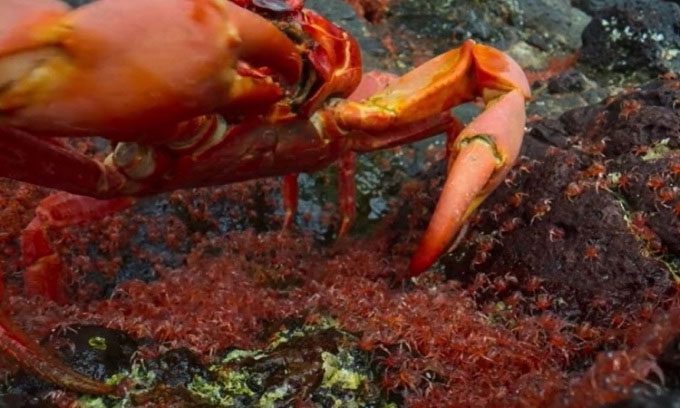Young crabs emerging from the sea and crawling into the forest face the threat of cannibalistic adult crabs lurking along their path.
A scene from “Our Planet II,” narrated by British naturalist David Attenborough, captures the moment when billions of young crabs bravely scuttle past adult crabs ready to feast on them along the shores of Christmas Island, Australia, as reported by Live Science on June 13.

Adult red crabs waiting to prey on young crabs. (Photo: Live Science)
Christmas Island red crabs (Gecarcoidea natalis) migrate once a year. It is estimated that 65 million crabs travel 2 kilometers from their forest habitats to their breeding grounds along the coast. This migration begins after the first rain of the wet season, typically in October or November, according to the Australian National Parks Agency. Upon reaching the beach, male crabs dig burrows and mate with females. Males transfer sperm for females to store in their pouch and then leave. Females remain behind, laying up to 100,000 eggs at a time in a brood pouch attached to their abdomen.
The egg-laying process occurs before dawn within a week after the full moon. Females release the fertilized eggs into the water as the tide begins to recede. The fertilized eggs fall into the sea and hatch as soon as they come into direct contact with the water, according to Lucy Turner, a marine biologist at the University of Plymouth, UK.
For over a month, going through several different larval stages, the young crabs develop into a stage known as megalopa. In the video from “Our Planet II”, they make their way back to land. As they emerge from the water, they shed their waterlogged exoskeletons to become fully formed crabs with a diameter of 5 mm. However, as soon as the young crabs reach the beach, danger lurks. An adult crab waits, using its claws to catch the tiny young crabs and devour them.
“Red crabs are opportunistic predators and are ready to eat anything. I have never seen them eat juvenile crabs before, but I have observed them consuming other dead adult crabs,” Turner stated.
Intraguild predation is particularly surprising since adult red crabs are typically not aggressive enough to actively hunt other individuals, according to Simon Webster, a zoologist at Bangor University, UK. After completing their migration, their muscle glycogen levels are extremely low, prompting them to consume anything they can find. According to Webster, they also feed on crabs that have died from overcrowding along the migration path. Only a small fraction of the young Christmas Island red crabs make it to safety in the forest. Many are killed even before leaving the sea. Scientists estimate that only 1% to 10% of the young crabs reach the shore and survive to adulthood.




















































